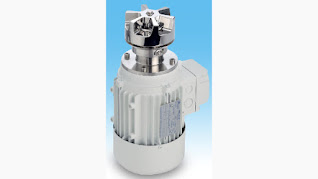In Tank Mixer Importance and Application in Chemical Industry
 |
| In Tank Mixer Importance and Application in Chemical Industry |
In the world of chemicals, where crucial mixtures are created
and new materials are formed every day, there's a key enabler to all these
processes that often doesn't get much attention. It’s the in-tank mixers.
These simple machines quietly power some of the complex chemical reactions and
enable the product creations that we use daily. From plastics and paints to
medicines and food additives, these mixers play a big part in every step of the
production process, turning raw materials into the finished products we know
and use.
What is the Principle of Mixing Tank?
Think of a big container filled with a mix of liquids and
solids swirling around—that's basically what a mixing tank looks like. Imagine
this swirling mix being carefully controlled to initiate the desired chemical
reactions—that's what the in-tank mixers
do. These mixers employ rotating impellers or blades to churn the contents of
the tank with controlled intensity and direction to achieve a specific mixing
outcome.
Depending on the desired chemical reaction or formulation
target, these outcomes can range from:
Homogenization: Creating a uniform solution by
thoroughly blending different liquids or dry solids together
Dispersion: Breaking down and evenly
distributing solid particles within a liquid medium
Emulsification: Suspending one immiscible liquid
like oil or vinegar within another like water or milk
Suspension: Keeping heavier solid particles
from settling at the bottom of the tank by maintaining a constant circulation
Heat Transfer: Facilitating efficient heating or
cooling of the tank contents through agitation
Types of In-Tank Mixers
In-tank mixers are not
universal. Different designs cater to unique needs and functionalities within
the chemical industry. Let’s take a look at some of the most common types:
Propeller Mixers: Versatile and efficient in nature,
they are ideal for general mixing tasks
Turbine Mixers: They offer high shear mixing
capabilities, thus proving ideal for rapid homogenization and dispersion
Anchor Mixers: They create gentle agitation and
are suitable for shear-sensitive materials
Paddle Mixers: Perfect for low-shear mixing for
blending viscous liquids
Exploring the Best: Quadro Liquids and IDEX In-Tank Mixers
When it comes to in-tank
mixers, Quadro Liquids and IDEX emerge as industry leaders. With a combined
legacy of innovation and commitment to excellence, their mixer solutions offer
unmatched advantages. Let’s underline some of those:
Unmatched Material Selection: Quadro
Liquids utilizes premium materials like stainless steel and Hastelloy to ensure
compatibility with a diverse range of chemicals and withstand harsh operating
conditions.
Advanced Design and Engineering: IDEX
boasts proprietary impeller designs and CFD (Computational Fluid Dynamics)
modelling expertise to guarantee optimal mixing performance and energy
efficiency.
Customizable Solutions: From standard
configurations to bespoke designs, Quadro Liquids and IDEX offer in-tank mixers tailored to
specific chemical processing requirements.
Global Support and Service Network: With
extensive manufacturing and service facilities worldwide, Quadro Liquids and
IDEX ensure prompt and reliable support for their clients.
Investing in the Right In-Tank Mixers: A Catalyst for
Chemical Success
Whether you are formulating cutting-edge adhesives or synthesizing
life-saving pharmaceuticals, choosing the right in-tank mixers can significantly impact your chemical processing
efficiency and product quality. Quadro Liquids and IDEX offer a comprehensive
portfolio of in-tank mixers backed by
unparalleled expertise, making them your trusted partners in achieving optimal
mixing outcomes and propelling your chemical endeavors to the forefront of
success.
Beyond the Basic Mix
While the fundamental roles of in-tank mixers involve homogenization, dispersion, and suspension,
the chemical possibilities extend far beyond. These versatile agitators play
crucial roles in a multitude of specialized chemical processes, including:
Chemical Reactions: Precise agitation facilitates controlled
contact between reactants, influencing reaction rates and product yields. For
instance, in a batch reactor where a new generation of biofuel is being synthesized,
the in-tank mixers ensure optimal
contact between enzymes and substrates, maximizing the conversion efficiency.
Heat Transfer: Efficient mixing enhances heat
transfer in exothermic or endothermic reactions. Imagine a large tank where a
highly viscous polymer blend needs to be cooled rapidly. The mixer distributes
the cooling medium evenly, preventing localized hot spots and ensuring uniform
product quality.
Gas-Liquid Mass Transfer: Certain chemical processes
involve the transfer of gases into liquids, like oxygen enrichment in
fermentation tanks. In-tank mixers
create the necessary surface area for efficient gas absorption, optimizing the
process.
Crystallization: Controlled agitation plays a vital
role in crystal size and morphology control during crystallization processes.
By influencing nucleation and crystal growth, in-tank mixers can tailor the properties of the final product,
impacting everything from drug delivery efficacy to the clarity of optical
lenses.
The Future of In-Tank Mixing
As the chemical industry embraces technological advancements,
in-tank mixing technology is evolving alongside. Here are a few exciting trends
shaping the future:
Smart Mixers: Integration of sensors and control
systems into mixers allows for real-time monitoring and adjustment of mixing
parameters, leading to enhanced process efficiency and product consistency.
Computational Fluid Dynamics (CFD): Advanced
simulations are used to optimize mixer design and predict mixing performance
under specific conditions, leading to tailored solutions for even the most
complex applications.
Sustainable Mixing: Energy-efficient mixer designs and
innovative materials are minimizing the environmental footprint of mixing
processes, aligning with the industry's focus on sustainability.
Conclusion
In-tank mixers might not
be visible, but they're the quiet powerhouses of the chemical industry. They
can carefully control how things are mixed, which lets us make a wide range of
chemical changes. This leads to the creation of new materials and products that
can change our lives. As technology gets better and the needs of the industry
change, these in-tank mixers will
keep playing a big role, helping to shape what's possible in chemistry with
every carefully controlled mix.



Comments
Post a Comment